Why Kona Became The World's Manta Ray Capital

Many people who book a manta ray dive in Kona assume it's just about being in the right place at the right time. But Kona's reputation as the world's best spot for manta encounters isn't just lucky geography. It's actually a perfect storm of unique conditions that you won't find anywhere else. After countless nights in these waters, local dive masters all agree it's an incredible synergy of factors that makes this place so special.
The Perfect Underwater Buffet
It all starts with the Big Island's volcanic geography. This creates deep-water upwelling currents that act like a natural conveyor belt, pulling nutrient-rich water and huge amounts of plankton toward specific spots along the coast. This sets up a reliable, all-you-can-eat buffet for manta rays nearly every single night. For the mantas, it’s an easy meal. For us divers, it means an unbelievably high chance of seeing them.
This natural feeding ground is made even better by consistently warm water and fantastic year-round visibility. The calm, protected bays create ideal conditions for both the gentle giants and the people who come to see them. This incredible consistency is what really separates Kona from other destinations where manta sightings can be hit-or-miss. The reliability has even turned the area into an amazing living laboratory. In fact, a long-term study at sites like "Manta Village" and "Manta Heaven" recorded sightings on six to seven nights a week. You can discover more about these frequent sightings and the data behind them.
Because the mantas show up so dependably, marine biologists have been able to create one of the most detailed manta ray databases in the world. Through decades of observation, researchers have identified over 290 individual manta rays, each with a unique belly pattern and its own personality. This means every dive is a chance to meet a known individual, turning a simple wildlife sighting into a much more personal experience. If you're curious to learn more, check out our post on why you should go on a manta ray dive in Kona.
Meeting Kona's Gentle Giants Face To Face
Swimming alongside a manta ray completely changes your perspective. You quickly realize they aren't just marine animals; they're individuals with distinct personalities that seasoned guides recognize dive after dive. The manta ray dive kona experience is so profound because you’re not just watching wildlife—you’re interacting with intelligent beings.
The Two Types of Kona Mantas
The Kona Coast is a special place where you can encounter two remarkable species. Each offers a different kind of magical interaction:
- Reef Manta Rays (Mobula alfredi): These are the acrobats you'll most likely meet during the night dive. Spanning an impressive 11-15 feet, they are known for being curious and interactive. It's not uncommon for them to glide right up to divers with what feels like genuine, playful curiosity, creating truly personal moments.
- Giant Manta Rays (Mobula birostris): Spotting one of these is a truly humbling experience. Reaching up to 20 feet from wingtip to wingtip, they command respect with their sheer size and graceful, physics-defying movements.
This incredible opportunity has made seeing manta rays a major draw for visitors. Each year, an estimated 80,000 people snorkel and dive with them in Hawaiʻi, a number that speaks volumes about the impact of these encounters. You can discover more insights about Hawaiian manta rays and their cultural significance.
Personalities of the Deep
In local Hawaiian culture, these magnificent creatures are honored as ‘hāhālua,’ spiritual guardians recognized for their intelligence. During your dive, you'll see this intelligence firsthand. Some mantas are bold, swimming right up to the lights and divers, while others are more reserved, gliding with a regal composure from a distance.
Thanks to an extensive cataloging system, your dive guide can often identify specific mantas by their unique belly spot patterns. They'll share stories about their behaviors and favorite feeding spots, connecting you to these animals on a much deeper level. This personal touch is what makes the Kona Honu Divers manta ray night dive an unforgettable adventure.
Selecting Your Perfect Manta Ray Adventure
Choosing the right operator for your manta ray dive in Kona can make or break the experience. It’s the difference between a truly unforgettable encounter and feeling like you're on just another crowded boat tour. The best companies prioritize small groups, usually capping their trips at a 6 to 12 person maximum. This small-group setting ensures you get personalized attention from dive masters who know the mantas by name and genuinely care about their well-being.
Look for operators who are invested in local research and conservation. These are the folks with the deepest knowledge and the most respectful approach to interacting with the wildlife. They aren't just there to pack the boat; they're there to share a profound natural wonder with you.
Snorkel or Scuba? Making the Call
Are you a snorkeler or a certified scuba diver? Your answer will shape your entire experience, as each offers a completely different perspective of the manta ballet.
- Snorkeling: This is your ticket to a stunning bird's-eye view. You'll float comfortably on the surface, holding onto a lighted board that attracts plankton. From there, you'll watch as the mantas swoop and glide through the light beams below you. It's an excellent option for families, non-swimmers, and anyone who wants a more relaxed experience.
- Scuba Diving: If you're a certified diver, this is the way to go for a truly immersive view. You'll settle on the sandy ocean floor and look up as these gentle giants perform their acrobatics directly overhead. It's not uncommon for a manta to glide within inches of your mask, a moment that will stay with you forever.
This decision tree can help you figure out the best path for getting equipped and ready for your adventure.

As the infographic illustrates, your current certification and comfort in the water are the starting points for planning your dive.
To help you weigh your options, here's a quick comparison of the different types of manta ray experiences you'll find in Kona.
Manta Ray Dive Options Comparison
| Experience Type | Duration | Group Size | Best For | Average Cost |
|---|---|---|---|---|
| Manta Snorkel | 1.5 – 2 hours | Small to Large | Families, non-divers, great surface views | $120 – $160 |
| Manta Scuba (1 Tank) | 2 – 2.5 hours | Small (6-12) | Certified divers, immersive up-close views | $160 – $210 |
| Advanced Scuba (2 Tanks) | 4 – 5 hours | Small (4-8) | Experienced divers, more bottom time | $200 – $250+ |
| Private Charter | Varies | Private | Ultimate flexibility, special occasions | $1,200+ |
This table shows that while snorkeling is a fantastic and accessible option, scuba diving offers a more intimate and bottom-up perspective, especially with smaller, more focused groups.
Smart Booking Questions
Before you hand over your credit card, be sure to ask a few key questions. A good operator will have no problem answering them. Ask about their exact group sizes, what their backup plan is for rough weather, and—most importantly—their policy if the mantas don't show up. It happens; they're wild animals, after all.
Top-tier companies like Kona Honu Divers are transparent about this and often offer a "manta guarantee," allowing you to come back on another night for free. You can find more details on their commitment to a quality experience by exploring their dedicated manta ray dive kona page. One final pro tip: ask about the timing. Trips scheduled around the new moon often mean darker skies, which can help concentrate the plankton and attract more mantas to the "campfire."
Gearing Up For Your Magical Night Encounter

Getting ready for a manta ray dive in Kona isn't quite like gearing up for a typical daytime plunge. The absolute star of your equipment list for this adventure isn't your regulator or BCD—it's your dive light. But this light does more than just cut through the darkness. It's the key to the whole show, acting as a powerful magnet for the plankton that manta rays feast on. This creates a concentrated buffet that brings the gentle giants right to you. While operators like Kona Honu Divers supply top-notch lights, carrying a small backup is always a smart idea, just in case.
More Than Just Gear: Physical and Mental Prep
Your choice of wetsuit is more important than you might think. Even with Hawaii's warm ocean temperatures, you'll be spending about 45 minutes relatively still on the seafloor. A good 3mm to 5mm wetsuit is crucial for keeping the chill away, letting you stay focused on the incredible manta display instead of on your shivering.
But some of the most critical prep work actually happens before you even step foot on the boat.
- Eat a Light Meal: Try to have a small, non-greasy meal about 2-3 hours before the dive. This simple step can help fend off seasickness and ensures you have enough energy for the excitement ahead.
- Stay Hydrated: Make sure you're drinking plenty of water throughout the day. The combination of salt air and anticipation can leave you more dehydrated than you realize.
- Practice Buoyancy: Your ability to remain perfectly still and hover is your secret weapon. By being a calm, passive observer, you become a non-threatening part of the environment. This invites curious mantas to glide in for those breathtaking, up-close moments you'll never forget.
While having the right gear for the manta dive is essential, it's always helpful to stay sharp on all your scuba skills. You can refresh your knowledge by exploring general scuba diving resources for more great information on equipment and techniques.
Exploring Kona's Legendary Manta Ray Sanctuaries
When you book a **manta ray dive in Kona**, you’ll quickly hear about two legendary spots: Manta Village and Manta Heaven. These aren’t just catchy names—they are recognized sanctuaries where the local geography, currents, and lights from nearby hotels have created the perfect feeding grounds. For decades, these conditions have consistently drawn mantas, essentially teaching generations of them that these locations are a reliable nightly buffet.
Manta Village vs. Manta Heaven
So, where will you be diving? The experience can be quite different depending on which site your dive operator chooses for the night. Each has its own distinct personality.
- Manta Village: This is the classic, original night dive spot. It’s in shallower water over a sandy bottom, which makes it a fantastic choice for divers who are newer to the sport or just want a more relaxed experience. The encounters here can feel incredibly up-close and personal as the mantas glide by in the calm water.
- Manta Heaven: Situated in deeper water, this site features more dramatic coral landscapes. It often draws larger groups of mantas, creating a breathtaking "fly-by" spectacle as they swoop and barrel-roll above you. The potential for a bit of current means it’s better suited for divers with solid buoyancy and swimming skills.
The reliability of these sites is truly remarkable and is supported by ongoing research. In fact, the very first manta ray identified in Kona was named Lefty, which kicked off a cataloging project that now tracks over 290 unique individuals. This research gives us a personal connection to these gentle giants. You can read more about this incredible manta identification project and what scientists have learned.
A skilled dive operator knows exactly how to position everyone for the best possible view while ensuring a safe and respectful distance from the wildlife. If conditions aren't ideal at one of the main sites, a top-notch company like Kona Honu Divers will always have backup locations scouted. This flexibility ensures your unforgettable Kona manta ray night dive is just as amazing, no matter where you anchor.
Mastering The Art Of Manta Ray Photography

Capturing those jaw-dropping images during your manta ray dive in Kona is about more than just having a nice camera. It’s a delicate dance between technical know-how and a real understanding of how mantas behave. If you get one of those wrong, you could easily miss that perfect shot. The biggest secret? Stop chasing them. Mantas are incredibly curious and will often come to investigate divers who are patient and still.
Dialing In Your Camera Settings
The low-light conditions of a night dive are your biggest hurdle. Getting your camera settings right is the best way to cut through the darkness and get sharp, clear photos of these fast-moving animals. You’ll be surprised how much light you can pull in with a few simple adjustments.
A higher ISO is pretty much non-negotiable here. Don't be afraid to push it into the 1600-3200 range to capture enough light without getting a ton of motion blur. You'll also want to open up your lens with a wide aperture, aiming for something between f/2.8 and f/4. This lets the maximum amount of available light reach your camera’s sensor. Remember, your underwater lights and strobes are doing double duty—they light up the mantas for your photo and attract the plankton that brings them in close.
To help you get started, here's a quick guide to some recommended camera settings for different underwater lighting scenarios.
| Lighting Condition | ISO Range | Aperture | Shutter Speed | Focus Tips |
|---|---|---|---|---|
| Dim Ambient Light (Early Dive) | 800-1600 | f/4 – f/5.6 | 1/125s | Use continuous autofocus to track mantas as they approach. |
| Complete Darkness (Peak Dive) | 1600-3200 | f/2.8 – f/4 | 1/100s | Pre-focus on your dive light's beam where plankton gathers. |
| Using Strong Strobes | 400-800 | f/5.6 – f/8 | 1/160s | Use a single-point focus aimed at the manta's eyes or gills. |
| Capturing Silhouettes | 800-1200 | f/8 – f/11 | 1/200s | Focus on the brighter surface water behind the manta. |
These settings are a great starting point, but always be ready to adjust based on your specific conditions and gear. The key is to balance light intake with image sharpness.
Composition and Respectful Shooting
Underwater composition is a completely different world. A classic and effective technique is shooting upward, which frames the manta against the brighter surface. This creates a stunning silhouette effect and really emphasizes their massive wingspan. For a different perspective, a side-angle shot is fantastic for showing off their graceful movements and the unique spot patterns on their bellies.
In the end, the most critical element isn't technical at all—it's your behavior. Photographers who are respectful, maintain a safe distance, and avoid sudden movements are the ones who get rewarded with incredible images of natural behavior. As you get ready for your trip, keep in mind that understanding these gentle giants is the real key. You can learn more about what makes the manta ray night dive with Kona Honu Divers such a special experience.
Extending Your Kona Manta Ray Magic
The incredible feeling you get after your manta ray dive in Kona doesn’t just stop when you get back on the boat. It’s a powerful memory, and with a little planning, you can make that single dive the high point of an amazing Big Island trip. The adrenaline from the dive can make it hard to wind down, so a smart move is to book a place to stay near Kailua-Kona that’s cool with late arrivals and won't mind if you have an early start the next day.
Make the Most of Your Trip
Once you’re out of the water, you’ll probably be starving. Luckily, plenty of local spots get the diver's schedule and offer late-night meals for returning crews and big, hearty breakfasts for those heading out again. You might even find yourself wanting another go. Many people realize that just one manta encounter isn't enough; the experience is so profound it turns into a yearly trip. Every dive offers something new, like seeing familiar manta rays or witnessing different seasonal behaviors.
Deepen Your Connection
Looking to add even more meaning to your adventure? Consider supporting local manta ray conservation. Groups like the Manta Pacific Research Foundation have educational programs that give you a much deeper appreciation for these magnificent creatures.
When you're trying to share the experience with friends and family back home, a few photos might not be enough. A great way to capture the real magic of swimming alongside these ocean giants is by putting together a video or keeping a detailed travel journal. It’s a fantastic way to encourage others to appreciate and protect our beautiful marine world.
Ready to create your own manta ray magic? Book your unforgettable dive with Kona Honu Divers today!
